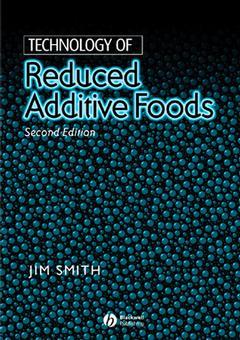Description
Technology of Reduced Additive Foods (2nd Ed.)
Coordinator: Smith Jim
Language: English
Subject for Technology of Reduced Additive Foods:
240 p. · 17.8x25.2 cm · Hardback
Description
/li>Contents
/li>Biography
/li>
The first edition of this book was widely accepted as a key reference in this subject, and this new edition has been thoroughly revised throughout to reflect current trends and practice. The chapters on packaging, marine-derived ingredients, animal-derived ingredients and reduced-additive breadmaking have all been extensively revised and additional authors and co-authors have been recruited for the second edition. Topics such as active packaging, good manufacturing practice, HACCP and natural ingredients have been reviewed with regards to their effect on the technology of reduced-additive foods.
Keith G Anderson.
1.1 Introduction.
1.2 Mechanical upgrading of underutilised carcass meat.
1.3 Surimi.
1.3.1 Surimi from fish.
1.3.2 Red meat and poultry surimi.
1.4 Upgrading of meats using fractionation techniques.
1.5 Ingredients from blood.
1.6 Egg and other products.
1.7 Potential techniques for the production of animal-derived ingredients.
1.7.1 Ultrafiltration.
1.7.2 Membrane and membraneless osmosis.
1.7.3 Solvent extraction.
1.7.4 Supercritical extraction.
1.7.5 Enzyme modification.
1.7.6 Spray dying.
1.7.7 Fluidised-bed drying.
1.7.8 Thermoplastic extrusion.
1.8 Conclusions.
References.
2 New marine-derived ingredients.
Torger Børresen.
2.1 Introduction.
2.2 Additive or ingredient?.
2.3 The basis for new marine-derived ingredients.
2.4 Specific marine-derived compounds.
2.5 New marine-derived ingredients.
2.5.1 Antioxidants.
2.5.2 Taste-adding substances.
2.5.3 Water-binding agents.
2.5.4 Compounds active against microbes.
2.5.5 Enzymes.
2.6 Marine-derived ingredients being an integral part of the food.
2.7 Ingredients obtained from marine algae and bacteria.
References.
3 The technology of reduced additive breadmaking.
Terry Sharp.
3.1 Introduction.
3.2 Why are additives used?.
3.3 Key steps in breadmaking.
3.3.1 Inclusion of air.
3.3.2 Expansion of bubbles.
3.3.3 Retention of gases.
3.4 Compensating for raw material variation.
3.5 Improvement of dough-handling characteristics.
3.6 Extending the shelf-life of bread.
3.6.1 Organoleptic changes.
3.6.2 Microbial changes.
3.7 Conclusions.
References.
4 Novel Food Packaging.
Michael L Rooney and Kit L Yam.
4.1 Introduction.
4.2 Scope for avoidance of additives.
4.2.1 Food degradation processes.
4.2.2 Characteristic needs of foods.
4.3 Properties of packaging materials.
4.4 Packaging processes.
4.4.1 Gas atmosphere treatments.
4.4.2 Thermal treatments.
4.5 Active packaging technologies.
4.5.1 Oxygen scavengers.
4.5.2 Carbon dioxide control.
4.5.3 Water vapour control.
4.5.4 Ethylene scavenging.
4.5.5 Antimicrobial food packaging.
4.5.6 Anti-oxidant releasing packaging.
4.6 Future opportunities.
References.
5 Antimicrobial preservative-reduced foods.
Nikki Beales and Jim Smith.
5.1 Introduction.
5.2 Control of microorganisms.
5.2.1 Antimicrobial preservatives in foods.
5.2.2 Hurdle concept.
5.2.3 Formulations.
5.2.4 Processing environment.
5.2.5 Processing methods.
5.2.6 Packaging methods.
5.3 Alternatives to antimicrobial preservatives.
5.3.1 Nitrite alternatives.
5.3.2 Sulphite alternatives.
5.3.3 Low sodium products.
5.4 Alternative natural food preservation systems.
5.4.1 Natural antimicrobials found in animals and animal products.
5.4.2 Natural antimicrobials from microorganisms.
5.4.3 Natural antimicrobials from plants.
5.5 Combinations of existing preservative mechanisms and natural preservatives.
5.6 Conclusions.
References.
Further reading.
6 New plant-derived ingredients.
Nazmul Haq.
6.1 Introduction.
6.2 High protein species.
6.3 Fruits and Nuts.
6.4 Culinary herbs and spices.
6.5 Essential oils.
6.6 Beverages and drinks.
6.7 Sugars and Sweeteners.
6.8 Gums and starches.
6.9 New technology.
6.10 Conclusions.
Acknowledgements.
References.
Further reading.
7 Reduced additive brewing and winemaking.
Creina S Stockley, T Nigel Sneyd and Terry H Lee.
7.1 Introduction: quality is a perception rather than a measurable parameter.
7.1.1 Winemaking.
7.1.2 Brewing.
7.1.3 Definition of an additive.
7.2 Antimicrobial agents.
7.2.1 Microbial spoilage in brewing.
7.2.2 Microbial spoilage in winemaking.
7.2.3 Addition of SO2 in winemaking.
7.2.4 Alternative additives to SO2 in winemaking.
7.2.5 Technological methods to reduce the amount of SO2 added.
7.2.6 Use of nisin in brewing.
7.3 Antioxidants.
7.3.1 Oxidation in brewing.
7.3.2 Oxidation in winemaking.
Acknowledgements.
References.
Further reading.
8 Food from supplement-fed animals.
Cameron Faustman.
8.1 Introduction.
8.2 Vitamin E supplementation.
8.2.1 Forms of vitamin E.
8.2.2 Vitamin E absorption.
8.2.3 Distribution of vitamin E within muscle.
8.2.4 Vitamin E and reduced lipid oxidation in muscle foods and milk.
8.2.5 Vitamin E supplementation and improved oxymyoglobin stability.
8.2.6 Effective antioxidant concentration of vitamin E in muscle foods.
8.2.7 Additional potential benefits of vitamin E to muscle foods.
8.2.8 Interaction between vitamin E and other nutrients in foods.
8.2.9 Cholesterol oxide formation and vitamin E.
8.2.10 Exogenous addition of vitamin E to meat products.
8.2.11 Potential of vitamin E toxicity in meat-producing animals.
8.3 Carotenoids.
8.3.1 Introduction.
8.3.2 Carotenoid supplementation in fish husbandry.
8.3.3 Carotenoid supplementation in fish – food science concerns.
8.3.4 Carotenoid supplementation in poultry.
8.4 Vitamin C.
8.5 Cholesterol reduction.
8.6 Alteration of fatty acid profile.
8.7 Competitive exclusion.
8.8 Summary.
Acknowledgements.
References.
9 Starter cultures.
Gunnar Mogensen.
9.1 Introduction.
9.2 Dairy products.
9.2.1 Additives used in dairy products.
9.2.2 Start cultures for dairy products.
9.2.3 Starters as substitutes for additives.
9.2.4 Future aspects.
9.3 Meat products.
9.3.1 Additives used in fermented meat products.
9.3.2 Starter cultures for meat products.
9.3.3 Starter cultures as substitutes for meat additives.
9.3.4 Future aspects.
9.4 Bread products.
9.4.1 Additives used in wheat bread products.
9.4.2 Additives used in rye bread products.
9.4.3 Microbiology applied in bread production.
9.4.4 Starter cultures as substitutes for bread additives.
9.4.5 Future aspects.
9.5 Genetic stability of lactic acid bacteria.
9.6 Possibilities in classical and modern technology.
Acknowledgements.
References.
Index




